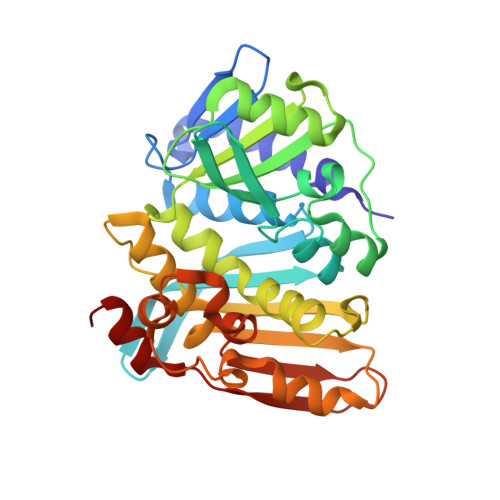The Crystal Structure of Methenyltetrahydromethano- Pterin Cyclohydrolase from the Hyperthermophilic Archaeon Methanopyrus Kandleri
Grabarse, W., Vaupel, M., Vorholt, J.A., Shima, S., Thauer, R.K., Wittershagen, A., Bourenkov, G., Bartunik, H.D., Ermler, U.(1999) Structure 7: 1257
- PubMed: 10545331
- DOI: https://doi.org/10.1016/s0969-2126(00)80059-3
- Primary Citation of Related Structures:
1QLM - PubMed Abstract:
The reduction of carbon dioxide to methane in methanogenic archaea involves the tetrahydrofolate analogue tetrahydromethanopterin (H(4)MPT) as a C(1) unit carrier. In the third step of this reaction sequence, N(5)-formyl-H(4)MPT is converted to methenyl-H(4)MPT(+) by the enzyme methenyltetrahydromethanopterin cyclohydrolase. The cyclohydrolase from the hyperthermophilic archaeon Methanopyrus kandleri (Mch) is extremely thermostable and adapted to a high intracellular concentration of lyotropic salts. Mch was crystallized and its structure solved at 2.0 A resolution using a combination of the single isomorphous replacement (SIR) and multiple anomalous dispersion (MAD) techniques. The structure of the homotrimeric enzyme reveals a new alpha/beta fold that is composed of two domains forming a large sequence-conserved pocket between them. Two phosphate ions were found in and adjacent to this pocket, respectively; the latter is displaced by the phosphate moiety of the substrate formyl-H(4)MPT according to a hypothetical model of the substrate binding. Although the exact position of the substrate is not yet known, the residues lining the active site of Mch could be tentatively assigned. Comparison of Mch with the tetrahydrofolate-specific cyclohydrolase/dehydrogenase reveals similarities in domain arrangement and in some active-site residues, whereas the fold appears to be different. The adaptation of Mch to high salt concentrations and high temperatures is reflected by the excess of acidic residues at the trimer surface and by the higher oligomerization state of Mch compared with its mesophtic counterparts.
- Max-Planck-Institut für terrestrische Mikrobiologie, Karl-von-Frisch-Strasse, 35043, Marburg, Max-Planck-Institut für Biophysik, Heinrich-Hoffmann-Strasse 7, 60528, Frankurt, Germany.
Organizational Affiliation:

















